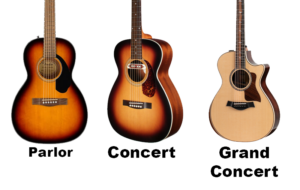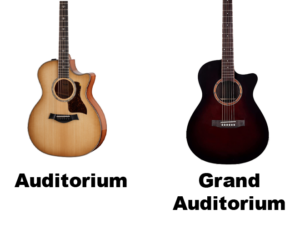Uncategorized
Unveiling the Magic: Exploring “Hallelujah” on Guitar
In the enchanting world of music, certain songs possess the power to touch our hearts, stir our souls, and linger in our minds long after the final note fades away. “Hallelujah” is undeniably one such song, a timeless masterpiece that has captivated audiences with its emotive lyrics and haunting melody. As aspiring guitarists, learning to play “Hallelujah” on guitar opens a door to a realm of emotion and beauty that transcends time. In this article, we’ll embark on a melodious journey through the chords, strumming patterns, and nuances that breathe life into “Hallelujah” on the guitar. So, let’s tune our strings, open our hearts, and dive into the magical realm of “Hallelujah.”
The Elegance of “Hallelujah”: A Musical Gem
Written by the legendary singer-songwriter Leonard Cohen, “Hallelujah” is a masterpiece that beautifully marries poetic lyrics with a hauntingly evocative melody. This song has been covered by numerous artists across genres, each infusing their unique interpretation into its soul-stirring tapestry. The guitar, with its ability to convey both delicate nuances and powerful emotions, serves as the perfect canvas to recreate the heartfelt essence of “Hallelujah.”
Chords That Echo Emotion
To embark on your “Hallelujah” guitar journey, familiarize yourself with the essential chords that form the foundation of the song:
1. C Major: The gentle and inviting C major chord serves as the starting point of the song, creating an atmosphere of openness and vulnerability.
2. A Minor: Transitioning to the A minor chord adds a touch of melancholy and introspection, infusing depth into the song’s narrative.
3. F Major: The F major chord introduces a sense of yearning and longing, adding an emotive layer to the melody.
4. G Major: Concluding with the G major chord, the song finds resolution and upliftment, evoking a feeling of acceptance and release.
Strumming Patterns: Breathing Life into Melody
While the chords provide the structural framework, the strumming patterns infuse “Hallelujah” with its distinct rhythm and emotion. Experiment with different strumming patterns to find the one that resonates most with your interpretation:
1. Down-Down-Up-Up-Down: This pattern adds a gentle and flowing quality, perfectly complementing the song’s tender lyrics.
2. Down-Up-Down-Up-Down-Up: With a more rhythmic and uplifting feel, this pattern injects a sense of energy and optimism into the melody.
3. Fingerstyle Picking: For a more intricate approach, explore fingerstyle picking techniques that delicately pluck individual strings to create a captivating, ethereal sound.
Singing with Sincerity
As you master the chords and strumming patterns, remember that the heart of “Hallelujah” lies in its emotive delivery. Allow your voice to become a vessel for the song’s profound emotions, conveying its raw vulnerability and poignant beauty. Embrace the lyrics with sincerity, infusing each word with the depth of your own interpretation.
Adding Your Personal Flourish
One of the remarkable aspects of “Hallelujah” is its ability to accommodate personal interpretation and creativity. Feel free to add your own stylistic flourishes, such as subtle embellishments between chords or variations in dynamics. These touches will breathe a unique essence into your rendition, making it a reflection of your individual musicality.
Practice, Patience, and Passion
Learning to play “Hallelujah” on guitar is a journey that requires practice, patience, and passion. Take the time to familiarize yourself with the chords, experiment with strumming patterns, and explore various vocal nuances. Each moment of practice brings you closer to unlocking the song’s captivating magic.
A Timeless Connection
As you strum the chords and sing the lyrics, you’ll find yourself enveloped in the timeless connection that “Hallelujah” creates between musician and audience. The delicate balance between melancholy and hope, vulnerability and strength, makes this song a masterpiece that resonates with the human experience. By learning to play “Hallelujah” on guitar, you not only embrace a beautiful musical journey but also tap into the universal language of emotions that binds us all.
So, let your fingers dance across the strings, and let your voice carry the echoes of “Hallelujah.” With every chord you strum and every note you sing, you breathe life into a melody that has touched countless hearts. As you embark on this musical voyage, remember that you are not merely playing a song—you are becoming part of a rich tapestry of musicians who have woven their souls into the fabric of “Hallelujah.”
Uncategorized
Acoustic Guitar Sizes: Finding Your Perfect Fit
Have you ever wondered how the size of an acoustic guitar affects its sound? From the intimate, focused tones of a parlor guitar to the deep, resonant sound of a jumbo, the size and shape of an acoustic guitar can have a profound impact on its sonic characteristics.”
In this article, we’ll explore acoustic guitar sizes, their variations, and how to choose the perfect size that suits your needs.
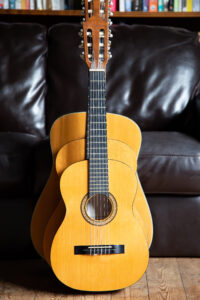 Understanding Acoustic Guitar Sizes: A Musical Puzzle
Understanding Acoustic Guitar Sizes: A Musical Puzzle
Acoustic guitar sizes refer to the dimensions and proportions of the guitar body, which significantly influence the instrument’s tonal characteristics, projection, and playability.
Just like pieces of a musical puzzle, different sizes create distinct voices that cater to various playing styles and preferences.
The Spectrum of Acoustic Guitar Sizes
Acoustic guitars come in several sizes, each with its unique qualities and attributes. Let’s explore some common acoustic guitar sizes and their defining features:
-
-
Parlor Guitar: The parlor guitar is petite and charming, making it an ideal companion for intimate settings.
The name comes from the rooms in which the guitar was typically played in the late 19th century.
Some famous musicians who have been known to use the parlor guitar are, Eric Clapton, Mark Orton, Ed Sheehan, and John Mayer
Its smaller size results in a focused and balanced sound, perfect for fingerpicking and folk music.
-
Concert Guitar: Slightly larger than the parlor guitar, the concert guitar offers enhanced projection and volume. It strikes a balance between portability and sound, making it versatile for various genres.
It is often used in classical music and flamenco music with its full sound.
-
Grand Concert Guitar: With a larger body than the concert guitar, the grand concert guitar boasts a fuller sound and improved tonal complexity.
A popular choice for those who have a smaller stature and require an instrument that’s built to a shorter scale. Great choice for traveling musicians who often play live performances.
It’s suitable for fingerstyle playing and intricate arrangements.
-
Auditorium Guitar: The auditorium guitar, also known as the orchestra model (OM), features a well-rounded sound with a pronounced midrange.
More shallower than the dreadnought and narrower in width than a concert guitar. An Auditorium guitar brings the body closer to the player, making it feel more intimate and comfortable for stage use.
Some famous musicians who play it include Ed Sheeran, John Mayer, and Eric Clapton.
-
Grand Auditorium Guitar: Expanding on the auditorium guitar’s design, the grand auditorium guitar offers a versatile sound profile with enhanced bass response and overall volume.
It is a versatile mid-sized guitar that is a good choice for those who want a single guitar to travel with. The tone is great for strumming and picking. It performs well on stage and in the studio.
It suits a wide range of musical genres.
-
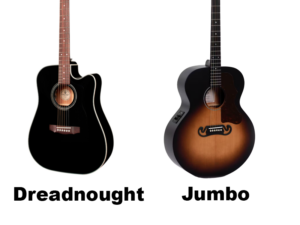 Dreadnought Guitar: The Dreadnought is a true icon, known for its bold and powerful sound. Its large body produces a strong bass response, making it ideal for strumming and vocal accompaniment.
Dreadnought Guitar: The Dreadnought is a true icon, known for its bold and powerful sound. Its large body produces a strong bass response, making it ideal for strumming and vocal accompaniment.This guitar is known for its powerful voice and lower-mid-rich tones that make it a favored choice for country artists. Although it is a popular choice for musicians of all genres.
Some famous musicians who play the dreadnought guitar include Hank Williams Jr, Elvis Presley, Keith Richards, Thom Yorke, and Kurt Cobain.
The original dreadnought guitars were made for the Oliver Ditson Company and featured mahogany backs and sides and spruce tops.
-
Jumbo Guitar: The jumbo guitar lives up to its name with a massive body that delivers robust volume and a deep bass presence.
This is the largest of the guitar family with a deeper body than the popular dreadnought. The body is wider and deeper than traditional acoustic guitars, which gives them a unique appearance.
Jumbo’s are well suited to rhythm guitarists in country and folk rock, and produce a deep rich sound favored by heavy strummers. Some famous musicians who play this guitar are Elvis Presley, George Harrison of the Beatles, Neil Young, Sheryl Crow, and Pete Townshend of The Who.
Choosing the Right Acoustic Guitar Size for You
Selecting the right acoustic guitar size involves considering factors such as playing style, comfort, and tonal preferences. Here are some steps to guide you on your quest:
-
Identify Your Playing Style: Determine whether you lean towards fingerpicking, strumming, or a mix of both. Different sizes excel in different playing styles, so choose one that complements your technique.
-
Consider Body Comfort: Hold and play guitars of various sizes to assess comfort. A guitar that fits well against your body ensures a pleasant playing experience, especially during extended sessions.
-
Evaluate Sound Preferences: Listen to the sound produced by different acoustic guitar sizes. Pay attention to tonal qualities, such as warmth, brightness, and projection, to find the one that resonates with your musical taste.
The Influence of Acoustic Guitar Sizes on Music
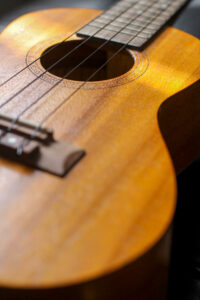 Acoustic guitar sizes and shapes can have a significant impact on the sound of the instrument.
Acoustic guitar sizes and shapes can have a significant impact on the sound of the instrument.The size of the guitar body type also relates to the volume of air within the instrument. Changes to the air capacity of the body will emphasize specific frequencies. A smaller body will have a more focused sound centered on higher frequencies, while a larger body will produce deeper low-end frequencies.
Body dimensions can provide some indication of the tone you might expect, but other factors exert a profound influence, too. Much depends on the tonewoods used to construct the body and the shape, size, and layout of the braces.
Finding Harmony in Acoustic Guitar Sizes
By delving into the nuances of size, sound, and playability, you’ve gained insights that will guide you toward the perfect fit for your musical aspirations.
As you continue your exploration, remember that each acoustic guitar size has its own unique voice and character. Embrace the joy of trying different sizes, celebrate the nuances of their sounds, and let your heart lead you to the one that resonates with your musical soul.
-
Uncategorized
Mastering the Asus Chord on Guitar: Elevate Your Melodic Journey
Greetings, fellow guitar enthusiasts and budding musicians! Are you ready to embark on a melodious adventure and explore the captivating realms of the Asus chord on guitar? Today, we’ll dive into the harmonious world of this versatile chord, unraveling its secrets and understanding how to play it with finesse. Whether you’re a beginner eager to expand your chord repertoire or a curious soul seeking to enhance your musical skills, this guide is your gateway to mastering the alluring “Asus chord guitar.” So, grab your guitar, find a cozy spot, and let’s dive into the harmonious realm of musical expression and creativity!
Demystifying the Asus Chord: A Harmonic Exploration
Imagine the Asus chord as a musical puzzle piece, waiting to be placed within the grand mosaic of your guitar playing. This chord, also known as A suspended chord, holds the power to evoke emotions and add depth to your musical creations. Let’s embark on a journey to unravel the enchanting mechanics of the Asus chord and bring its harmonious magic to life.
Playing the Asus Chord: Crafting Musical Brilliance
To play the Asus chord, follow these simple steps:
1. Finger Placement: Begin by placing your index finger on the 2nd fret of the D string (the fourth thickest string), marking the note A.
2. Middle Finger: Position your middle finger on the 2nd fret of the G string (the third thinnest string), creating the major second (B).
3. Ring Finger: Place your ring finger on the 3rd fret of the B string (the second thinnest string), forming the perfect fourth (E).
4. Strumming: Focus on strumming the A, D, G, and B strings (the thickest through second thinnest strings) while avoiding the high E string (the first string).
5. Sound Check: Strum the strings individually to ensure each note rings out clearly. Adjust finger placement if needed for a resonant sound.
Exploring Asus Chord Variations: Adding Flavor to Your Playing
While the Asus chord is inherently captivating, you can add variations to your playing to create different moods and atmospheres. Here are a couple of ways to experiment:
1. Fingerpicking Patterns: Delve into fingerpicking techniques to create intricate patterns that highlight the individual notes of the Asus chord.
2. Arpeggios: Practice playing the notes of the Asus chord individually in a sequence, crafting arpeggios that flow like a gentle stream.
The Asus Chord in Action: Musical Styles
The Asus chord’s versatility makes it a favorite choice across various musical genres. Here are a few popular songs that feature the Asus chord:
1. “Hotel California” by Eagles: The Asus chord contributes to the iconic intro of this timeless rock classic, setting the stage for a captivating musical journey.
2. “I’m Yours” by Jason Mraz: This feel-good tune features the Asus chord, infusing the melody with a sense of optimism and joy.
Tips for Mastering the Asus Chord
As you embark on your journey to master the Asus chord, consider these tips to enhance your playing:
1. Practice Regularly: Dedicate consistent practice sessions to build muscle memory and familiarity with the Asus chord.
2. Smooth Chord Transitions: Work on transitioning smoothly between the Asus chord and other chords to improve your overall playing fluency.
3. Experiment with Strumming Patterns: Vary your strumming patterns to explore different rhythmic possibilities and enhance your musical expression.
Conclusion: Embrace the Elegance of the Asus Chord
Congratulations, you’ve delved into the harmonious world of the Asus chord on guitar! As you strum, experiment with variations, and play songs, you’ll uncover the power of this chord to add depth, texture, and intrigue to your musical creations. Keep practicing, keep exploring, and keep embracing the enchanting allure of the Asus chord. It’s your key to unlocking a world of musical expression, where each note resonates with elegance and allure. So, pick up your guitar, let your fingers dance across the strings, and let the captivating Asus chord guide you toward a realm of melodies that captivate the senses and elevate the spirit, one harmonious note at a time!
Uncategorized
Strumming Joyful Tunes: Unveiling the Chords to “Happy Birthday”
In the symphony of life, few melodies hold as much universal charm as the timeless tune of “Happy Birthday.” It’s a melody that brings people together, evoking smiles, laughter, and warm memories. If you’ve ever wanted to strum this joyful tune on your guitar and join in the celebration, you’re about to embark on a musical journey. In this article, we’ll explore the chords to “Happy Birthday,” uncover the magic they hold, and guide you through the process of playing this beloved melody on your guitar. So, let’s pick up our guitars and dive into the world of chords that make “Happy Birthday” a musical gift of joy!
Chords That Sing of Celebration: The Magic of “Happy Birthday”
“Happy Birthday” is a melody that transcends cultures, languages, and generations. At its core are a set of chords that resonate with the joyous occasion of birthdays, making it a perfect tune to strum on a guitar.
Unlocking the Chords to “Happy Birthday”
To strum “Happy Birthday” on your guitar, you’ll need to familiarize yourself with a handful of simple chords:
1. G Major: The G major chord is your gateway to the celebratory melody. It’s the foundation upon which the joyous tune of “Happy Birthday” is built.
2. C Major: The C major chord adds a touch of brightness and variety to the progression, guiding the melody along its cheerful path.
3. D Major: The D major chord introduces a sense of movement and resolution, leading the melody to its delightful conclusion.
Strumming the Joy of “Happy Birthday”
Now that you know the chords, it’s time to strum the joy of “Happy Birthday” on your guitar. Here’s a step-by-step guide to get you started:
1. Chord Progression: Begin with the G major chord, strumming each chord for one measure. Transition to the C major chord for the next measure, and then to the D major chord for the subsequent measure.
2. Strumming Pattern: Keep the strumming pattern simple and steady. You can use a basic down-strumming pattern (down, down, down) or experiment with light and rhythmic strumming to add your personal touch.
3. Sing Along: As you strum the chords, invite friends, family, or the birthday celebrant to join in the singing. “Happy Birthday to you, Happy Birthday to you…”
Adding a Melodic Twist to “Happy Birthday”
Once you’ve mastered the basic chord progression, you can add a melodic twist to your rendition of “Happy Birthday.” Here’s how:
1. Melody Notes: Between chord changes, incorporate melody notes that correspond to the lyrics of “Happy Birthday.” These notes add a delightful embellishment to the tune.
2. Single-Note Melodies: Experiment with playing the melody notes individually, either by plucking them with your fingers or using a pick. This adds a charming touch to your guitar arrangement.
A Musical Gift of Joy: Strumming “Happy Birthday” Chords
Congratulations, you’ve embarked on a musical journey to uncover the chords to “Happy Birthday” on the guitar! By understanding the chords, strumming the celebratory tune, and adding your own melodic twists, you’ve gained insights that will allow you to share the gift of music and joy on special occasions.
As you continue your musical exploration, remember that “Happy Birthday” is more than just a tune – it’s a heartfelt melody that brings people together and spreads happiness. With each strum and pluck, you’re creating a musical gift that resonates with the essence of celebration and shared moments. So, pick up your guitar, strum the chords to “Happy Birthday,” and let the harmonious sounds fill the air with a symphony of joy. Happy strumming and happy birthdays to come!
-
advanced9 years ago
How to Play “Sleepwalk” on the 3-String Guitar! Guitar TABs Included!
-
beginner8 years ago
3-String or 4-String? How to Decide Which is Right for You!
-
beginner9 months ago
Exploring Different Guitar Types: A Beginner’s Guide
-
Blues Guitar8 years ago
Go-To Tunings for Blues Slide Guitar
-
advanced9 months ago
Fun and Effective Guitar Exercises: Elevate Your Playing with These 5 Simple Techniques
-
Uncategorized9 months ago
Acoustic Guitar Sizes: Finding Your Perfect Fit
-
Blues Guitar7 years ago
Jack Daniel’s Whiskey Barrel Guitar: How It’s Made and What it Sounds Like
-
Guitars9 months ago
Bass vs Guitar: Exploring the Musical Journey

